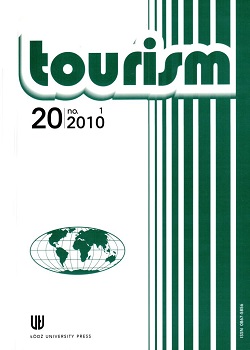Jakość produktu atrakcji turystycznych a zadowolenie, korzyści i zamiary zwiedzających: weryfikacja modelu
DOI:
https://doi.org/10.18778/0867-5856.20.1.04Keywords:
atrakcje turystyczne, jakość, zadowolenie, korzyści, zamiary, modelowanie równań strukturalnychAbstract
W pracy podjęto próbę weryfikacji modelu zależności pomiędzy motywacją, jakością produktu atrakcji turystycznych, korzyściami, zadowoleniem i zamiarami osób zwiedzających te atrakcje. Dane do analizy zebrano podczas Festynu Archeologicznego w Biskupinie wśród 582 osób zwiedzających Festyn. Stwierdzono, że oddziaływanie jakości produktu atrakcji na zamiary zwiedzających przebiega głównie ścieżką wiodącą przez korzyści wynoszone ze zwiedzania. Na przyszłe zamiary zwiedzających silniejszy całkowity wpływ mają korzyści niż ich zadowolenie.
Downloads
References
AJZEN I., FISHBEIN M., 1980, Understanding Attitudes and Predicting Social Behavior, Englewood Cliffs NJ: Prentice-Hill.
Google Scholar
BAKER D., CROMPTON J., 2000, Quality, Satisfaction and Behavioral Intentions, Annals of Tourism Research, 27(3), s. 785–804.
Google Scholar
DOI: https://doi.org/10.1016/S0160-7383(99)00108-5
BROWN P.J., 1984, Benefits of outdoor recreation and some ideas for valuing recreation opportunities, [in:] G.L. Peterson i A.Randall, eds., Valuation of wildland resource benefits, Boulder, CO: Westview Press, s. 209–220.
Google Scholar
GOTLEIB, J.B., D. GREWAL, S.W. BROWN, 1994, Consumer Satisfaction and Perceived Quality: Complementary or Divergent Constructs?, Journal of Applied Psychology, 79(6), s. 875–885.
Google Scholar
DOI: https://doi.org/10.1037/0021-9010.79.6.875
HAIR, J.F., BLACK, W.C., BABIN, B., ANDERSON, R.L., TATHAM R.L., 2007, Multivariate Data Analysis, New Jersey: Prentice Hall.
Google Scholar
HERZBERG F., 1966, Work and the nature of man, Cleveland: World Publishing Co.
Google Scholar
JENSEN J.M., 2004, The Application of Herzberg’s Two-factor Theory to the Realm of Tourist Attractions, New Zealand Tourism and Hospitality Research Conference, Wellington.
Google Scholar
JORESKOG K., SORBOM D., 1996, LISREL 8: User’s reference guide, Chicago, Scientific Software International.
Google Scholar
MIDDLETON V.C., 1996, Marketing w turystyce, PAPT, Warszawa.
Google Scholar
MOSCARDO G., 1996, Mindful Visitors. Heritage and Tourism, Annals of Tourism Research, 23(2), s. 376–397.
Google Scholar
DOI: https://doi.org/10.1016/0160-7383(95)00068-2
MOSCARDO G., 1999, Making Visitors Mindful. Principles for Creating Quality Sustainable Visitor Experiences through Effective Communication, Champaign, Illinois.
Google Scholar
NOWACKI M., 2000a, Rola interpretacji dziedzictwa w zarządzania atrakcjami turystycznymi, Problemy Turystyki, XXIII (3–4).
Google Scholar
NOWACKI M., 2000b, Analiza potencjału atrakcji krajoznawczej na przykładzie Muzeum Narodowego Rolnictwa w Szreniawie, [in:] A. Szwichtenberg, E. Dziegieć, eds., Przemysł turystyczny, Politechnika Koszalińska, Uniwersytet Łódzki, Koszalin, s. 147–164.
Google Scholar
OLIVIER, R.L., 1980, A Cognitive Model of Antecedents and Consequences of Satisfaction Decisions, Journal of Marketing Research, 17, pp. 460–469.
Google Scholar
DOI: https://doi.org/10.1177/002224378001700405
PEARCE P., 1988, The Ulysses Factor, Springer-Verlag, New York.
Google Scholar
DOI: https://doi.org/10.1007/978-1-4612-3924-6
PRENTICE R.C., 1993, Tourism and Heritage Attractions, London, Routledge.
Google Scholar
PRENTICE R.C., 1995, Evaluating the Experiences and Benefits Gained by Tourists Visiting A Socio-Industrial Heritage Museum: An Applica-tion of ASEB Grid Analysis to Blists Hill Open – Air Museum, The Ironbridge Gorge Museum, United Kingdom, Museum Management and Curatorship, 14 (4), s. 229–251.
Google Scholar
DOI: https://doi.org/10.1016/0260-4779(95)00046-1
SAGAN A., 2003, Model pomiarowy satysfakcji i lojalności. StatSoft Polska https://www.statsoft.pl/
Google Scholar
SWARBROOKE J., 1995, The Development and Management of Visitor Attractions, Butterworth-Heinemann Ltd, Oxford.
Google Scholar
TOMAS S.R., SCOTT D., CROMPTON J.L., 2002, An investigation of the relationships between quality of service performance, benefits sought, satisfaction and future intention to visit among visitors to a zoo, Managing Leisure, 7, s. 239–250.
Google Scholar
DOI: https://doi.org/10.1080/136067102100005589
VITTERSO J., VORKINN M., VISTAD O.I., VAGLAND J., 2000, Tourist Experiences and Attractions, Annals of Tourism Research, 27(2), s. 432–450.
Google Scholar
DOI: https://doi.org/10.1016/S0160-7383(99)00087-0
YI, Y., 1991, A Critical Review of Consumer Satisfaction, [in:] V.A. Zeithaml ed., Review of Marketing, American Marketing Association, Chicago, IL, s. 68–123.
Google Scholar
YOON Y., M. UYSAL, 2003, An examination of the effects of motivation and satisfaction on destination loyalty: a structural model, Tourism Management, 26, s. 45–56.
Google Scholar
DOI: https://doi.org/10.1016/j.tourman.2003.08.016
ZAKRZEWSKA M., 1994, Analiza czynnikowa w budowaniu i sprawdzaniu modeli empirycznych, Wydawnictwo Naukowe UAM, Poznań.
Google Scholar
Downloads
Published
How to Cite
Issue
Section
License

This work is licensed under a Creative Commons Attribution-NonCommercial-NoDerivatives 4.0 International License.










